Are Land Use Options in Viticulture and Oliviculture in Agreement with Bioclimatic Shifts in Portugal?
Abstract
1. Introduction
2. Materials and Methods
2.1. Data and Study Area
2.2. Köppen’s Climate Classification
2.3. Worldwide Bioclimatic Classification System (WBCS)
2.4. The Bioclimatic-Shift Exposure Index (BSEI)
2.5. Statistical Analysis
3. Results
3.1. Köppen–Geiger Climate Classification and WBCS
3.2. The Bioclimatic-Shift Expose Index (BSEI)
3.3. Land-Use Changes for Viticulture and Oliviculture from 1990 to 2018
4. Discussion
5. Conclusions
Supplementary Materials
Author Contributions
Funding
Institutional Review Board Statement
Informed Consent Statement
Data Availability Statement
Conflicts of Interest
References
- Climate Change and Land, An IPCC Special Report on Climate Change, Desertification, Land Degradation, Sustainable Land Management, Food Security, and Greenhouse gas fluxes in Terrestrial Ecosystems, Summary for policymakers. 2019. Available online: https://www.ipcc.ch/srccl/ (accessed on 9 July 2021).
- Tasser, E.; Leitinger, G.; Tappeiner, U. Climate Change versus Land-Use Change—What Affects the Mountain Landscapes More? Land Use Policy 2017, 60, 60–72. [Google Scholar] [CrossRef]
- Ellis, E.C. Sustaining biodiversity and people in the world’s anthropogenic biomes. Environ. Sustain. 2013, 5, 368–372. [Google Scholar] [CrossRef]
- Martins, I.S.; Proença, V.; Pereira, H.M. The unusual suspect: Land use is a key predictor of biodiversity patterns in the Iberian Peninsula. Acta Oecol. 2014, 61, 41–50. [Google Scholar] [CrossRef][Green Version]
- Haberl, H.; Erb, K.H.; Krausmann, F.; Gaube, V.; Bondeau, A.; Plutzar, C.; Gingrich, S.; Lucht, W.; Fischer-Kowalski, M. Quantifying and mapping the human appropriation of net primary production in earth’s terrestrial ecosystems. Proc. Natl. Acad. Sci. USA 2007, 104, 12942–12947. [Google Scholar] [CrossRef] [PubMed]
- Fernández-Nogueira, D.; Corbelle-Rico, E. Land Use Changes in Iberian Peninsula 1990–2012. Land 2018, 7, 99. [Google Scholar] [CrossRef]
- Van Vliet, J.; de Groot, H.L.F.; Rietveld, P.; Verburg, P.H. Manifestations and Underlying Drivers of Agricultural Land Use Change in Europe. Landsc. Urban Plan. 2015, 133, 24–36. [Google Scholar] [CrossRef]
- Levers, C.; Butsic, V.; Verburg, P.H.; Müller, D.; Kuemmerle, T. Drivers of Changes in Agricultural Intensity in Europe. Land Use Policy 2016, 58, 380–393. [Google Scholar] [CrossRef]
- De Chazal, J.; Rounsevell, M.D.A. Land-Use and Climate Change within Assessments of Biodiversity Change: A Review. Glob. Environ. Chang. 2009, 19, 306–315. [Google Scholar] [CrossRef]
- Lindner, M.; Maroschek, M.; Netherer, S.; Kremer, A.; Barbati, A.; Garcia-Gonzalo, J.; Seidl, R.; Delzon, S.; Corona, P.; Kolström, M.; et al. Climate Change Impacts, Adaptive Capacity, and Vulnerability of European Forest Ecosystems. For. Ecol. Manag. 2010, 259, 698–709. [Google Scholar] [CrossRef]
- Andrade, C.; Contente, J. Climate change projections for the Worldwide Bioclimatic Classification System in the Iberian Peninsula until 2070. Int. J. Climatol. 2020, 40, 5863–5886. [Google Scholar] [CrossRef]
- Diffenbaugh, N.S.; Pal, J.S.; Giorgi, F.; Gao, X. Heat Stress Intensification in the Mediterranean Climate Change Hotspot. Geophys. Res. Lett. 2007, 34. [Google Scholar] [CrossRef]
- Diffenbaugh, N.S.; Giorgi, F. Climate Change Hotspots in the CMIP5 Global Climate Model Ensemble. Clim. Chang. 2012, 114, 813–822. [Google Scholar] [CrossRef]
- Andrade, C.; Leite, S.M.; Santos, J.A. Temperature Extremes in Europe: Overview of Their Driving Atmospheric Patterns. Nat. Hazards Earth Syst. Sci. 2012, 12, 1671–1691. [Google Scholar] [CrossRef]
- Andrade, C.; Contente, J.; Santos, J.A. Climate Change Projections of Dry and Wet Events in Iberia Based on the WASP-Index. Climate 2021, 9, 94. [Google Scholar] [CrossRef]
- Santos, J.A.; Belo-Pereira, M.; Fraga, H.; Pinto, J.G. Understanding Climate Change Projections for Precipitation over Western Europe with a Weather Typing Approach. J. Geophys. Res. Atmos. 2016, 121, 1170–1189. [Google Scholar] [CrossRef]
- Santos, M.; Fonseca, A.; Fragoso, M.; Santos, J.A. Recent and Future Changes of Precipitation Extremes in Mainland Portugal. Theor. Appl. Climatol. 2019, 137, 1305–1319. [Google Scholar] [CrossRef]
- Scoccimarro, E.; Villarini, G.; Vichi, M.; Zampieri, M.; Fogli, P.G.; Bellucci, A.; Gualdi, S. Projected Changes in Intense Precipitation over Europe at the Daily and Subdaily Time Scales. J. Clim. 2015, 28, 6193–6203. [Google Scholar] [CrossRef]
- Vidal-Macua, J.J.; Ninyerola, M.; Zabala, A.; Domingo-Marimon, C.; Gonzalez-Guerrero, O.; Pons, X. Environmental and socioeconomic factors of abandonment of rainfed and irrigated crops in northeast Spain. Appl. Geogr. 2018, 90, 155–174. [Google Scholar] [CrossRef]
- Fraga, H.; de Cortázar Atauri, I.G.; Santos, J.A. Viticultural Irrigation Demands under Climate Change Scenarios in Portugal. Agric. Water Manag. 2018, 196, 66–74. [Google Scholar] [CrossRef]
- Fraga, H.; Santos, J.A. Assessment of Climate Change Impacts on Chilling and forcing for the Main Fresh Fruit Regions in Portugal. Front. Plant. Sci. 2021. [Google Scholar] [CrossRef]
- Köppen, W.; Geiger, R. Handbuch der Klimatologie; Gebrüder Bornträger: Berlin, Germany, 1930; Volume 6. [Google Scholar]
- Rivas-Martínez, S.; Sáenz, S.R.; Penas, A. Worldwide bioclimatic classification system. Glob. Geobot. 2011, 1, 1–634. [Google Scholar] [CrossRef]
- Rivas-Martínez, S.; Penas, A.; del Río, S.; González, T.; Rivas-Sáenz, S. Bioclimatology of the Iberian Peninsula and the Balearic Islands. In The Vegetation of the Iberian Peninsula.Plant and Vegetation; Loidi, J., Ed.; Springer: Cham, Switzerland, 2017; Volume 12. [Google Scholar] [CrossRef]
- Andrade, C.; Contente, J. Köppen’s climate classification projections for the Iberian Peninsula. Clim. Res. 2020, 81, 71–89. [Google Scholar] [CrossRef]
- Fernández-Nogueira, D.; Corbelle-Rico, E. Determinants of Land Use/Cover Change in the Iberian Peninsula (1990‒2012) at Municipal Level. Land 2019, 9, 5. [Google Scholar] [CrossRef]
- Turpin, N.; Berge, H.T.; Grignani, C.; Guzmán, G.; Vanderlinden, K.; Steinmann, H.H.; Siebielec, G.; Spiegel, H.; Perret, E.; Ruysschaert, G.; et al. An Assessment of Policies Affecting Sustainable Soil Management in Europe and Selected Member States. Land Use Policy 2017, 66, 241–249. [Google Scholar] [CrossRef]
- Jones, N.; de Graaff, J.; Rodrigo, I.; Duarte, F. Historical Review of Land Use Changes in Portugal (before and after EU Integration in 1986) and Their Implications for Land Degradation and Conservation, with a Focus on Centro and Alentejo Regions. Appl. Geogr. 2011, 31, 1036–1048. [Google Scholar] [CrossRef]
- Available online: https://www.ivv.gov.pt/np4/499/ (accessed on 30 June 2021).
- Available online: https://www.oiv.int/public/medias/7909/oiv-state-of-the-world-vitivinicultural-sector-in-2020.pdf (accessed on 9 July 2021).
- Available online: https://www.ivv.gov.pt/np4/7179.html (accessed on 9 July 2021).
- Available online: https://www.ivv.gov.pt/np4/163.html (accessed on 9 July 2021).
- Available online: https://www.gpp.pt/images/PEPAC/Anexo_NDICE_ANLISE_SETORIAL___AZEITE.pdf (accessed on 30 June 2021).
- Fonseca, A.R.; Santos, J.A. High-resolution temperature datasets in Portugal from a geostatistical approach: Variability and extremes. J. Appl. Meteorol. Climatol. 2018, 57, 627–644. [Google Scholar] [CrossRef]
- NASA. NASA Shuttle Radar Topography Mission Global 3 Arc Second Subsampled [Data Set]. Available online: https://lpdaac.usgs.gov/products/srtmgl3v003/ (accessed on 17 August 2021).
- Available online: https://snig.dgterritorio.gov.pt/ (accessed on 30 June 2021).
- Kottek, M.J.; Grieser, C.; Beck, B.; Rudolf, R. World map of the Köppen–Geiger climate classification updated. Meteorol. Z. 2006, 15, 259–263. [Google Scholar] [CrossRef]
- Wilcoxon, F. Individual comparisons by ranking methods. Biom. Bull. 1945, 1, 80–83. [Google Scholar] [CrossRef]
- Mann, H.B. Non-parametric tests against trend. Econometrica 1945, 13, 245–259. [Google Scholar] [CrossRef]
- Santos, J.A.; Fraga, H.; Malheiro, A.C.; Moutinho-Pereira, J.; Dinis, L.-T.; Correia, C.; Moriondo, M.; Leolini, L.; Dibari, C.; Costafreda-Aumedes, S.; et al. A review of the Potential Climate Change Impacts and Adaptation options for European Viticulture. Appl. Sci. 2020, 10, 3092. [Google Scholar] [CrossRef]
- Costa, J.M.; Oliveira, M.; Egipto, R.J.; Cid, R.J.; Fragoso, R.A.; Lopes, C.M.; Duarte, E.N. Water and Wastewater management for sustainable viticulture and oenology in south Portugal–A review. Ciência Téc. Vitiv. 2020, 35, 1–15. [Google Scholar] [CrossRef]
- Fraga, H.; Pinto, J.G.; Viola, F.; Santos, J.A. Climate Change Projections for Olive Yields in the Mediterranean Basin. Int. J. Climatol. 2020, 40, 769–781. [Google Scholar] [CrossRef]
- Fraga, H.; Moriondo, M.; Leolini, L.; Santos, J.A. Mediterranean Olive Orchards under Climate Change: A Review of Future Impacts and Adaptation Strategies. Agronomy 2021, 11, 56. [Google Scholar] [CrossRef]
- Oliveira, M.; Costa, J.M.; Fragoso, R.; Duarte, E. Challenges for modern wine production in dry areas: Dedicated indicators to preview wastewater flows. Water Supply 2019, 19, 653–661. [Google Scholar] [CrossRef]
- Martins, A.A.; Araújo, A.R.; Graça, A.; Caetano, N.S.; Mata, T.M. Towards sustainable wine: Comparison of two Portuguese wines. J. Clean Prod. 2018, 183, 662–676. [Google Scholar] [CrossRef]
- Fraga, H.; Malheiro, A.C.; Moutinho-Pereira, J.; Santos, J.A. Future scenarios for viticulture zoning in Europe: Ensemble projections and uncertainties. Int. J. Biometeorol. 2013, 57, 909–925. [Google Scholar] [CrossRef]
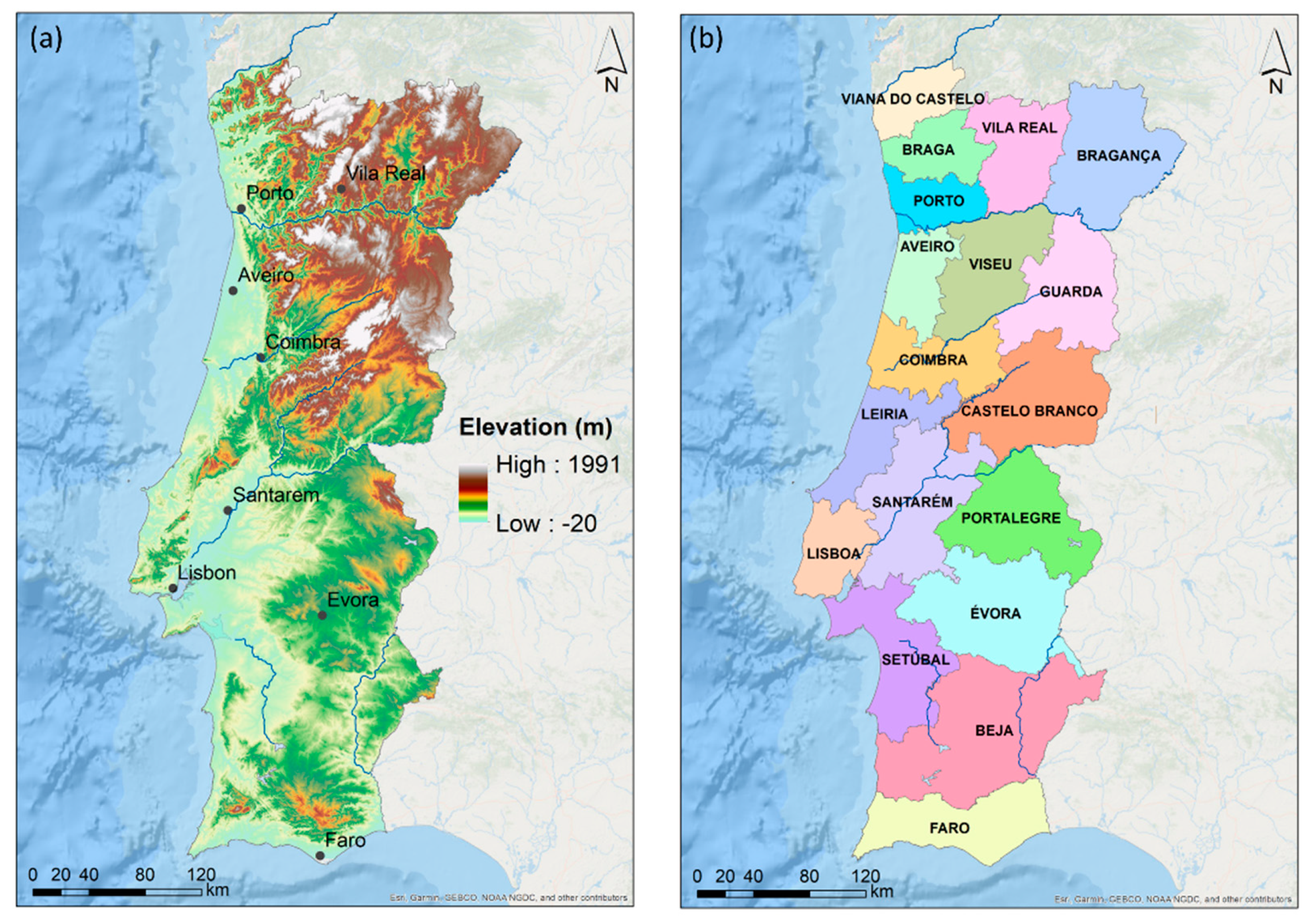
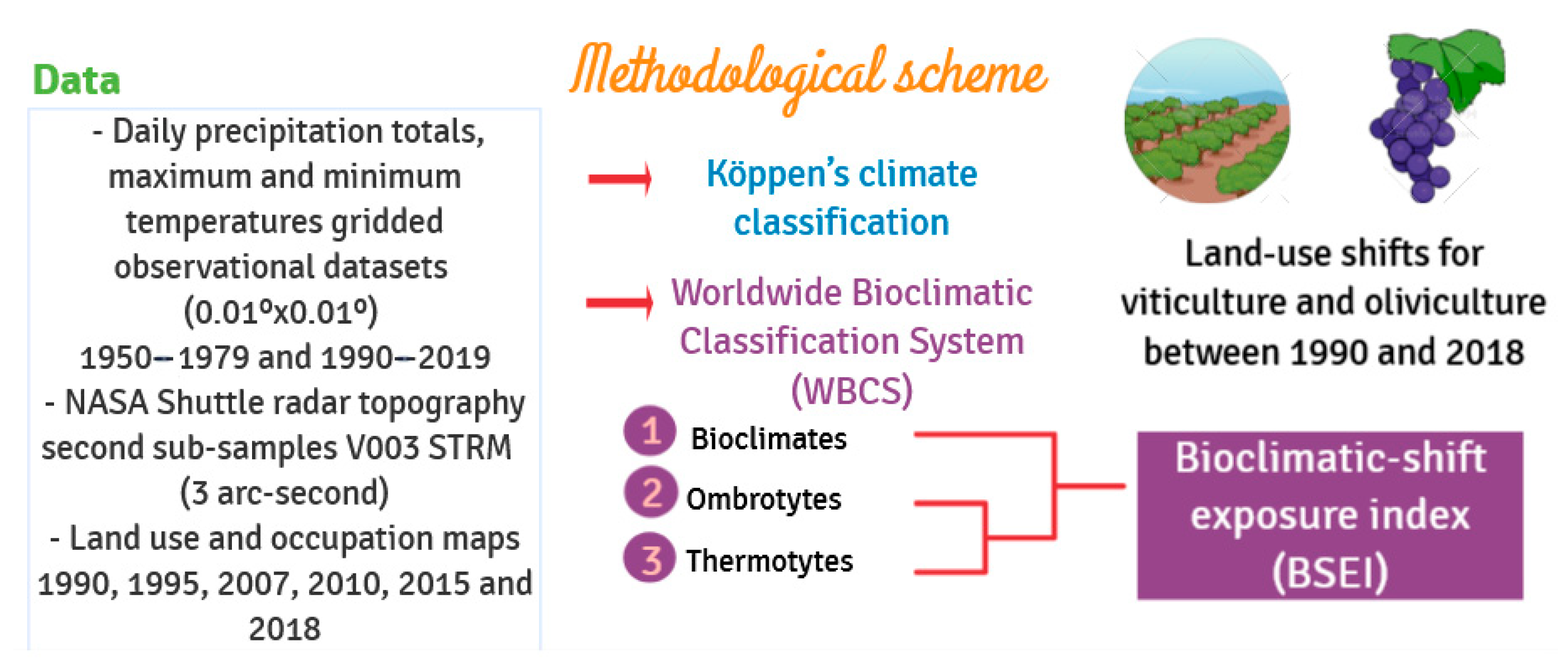
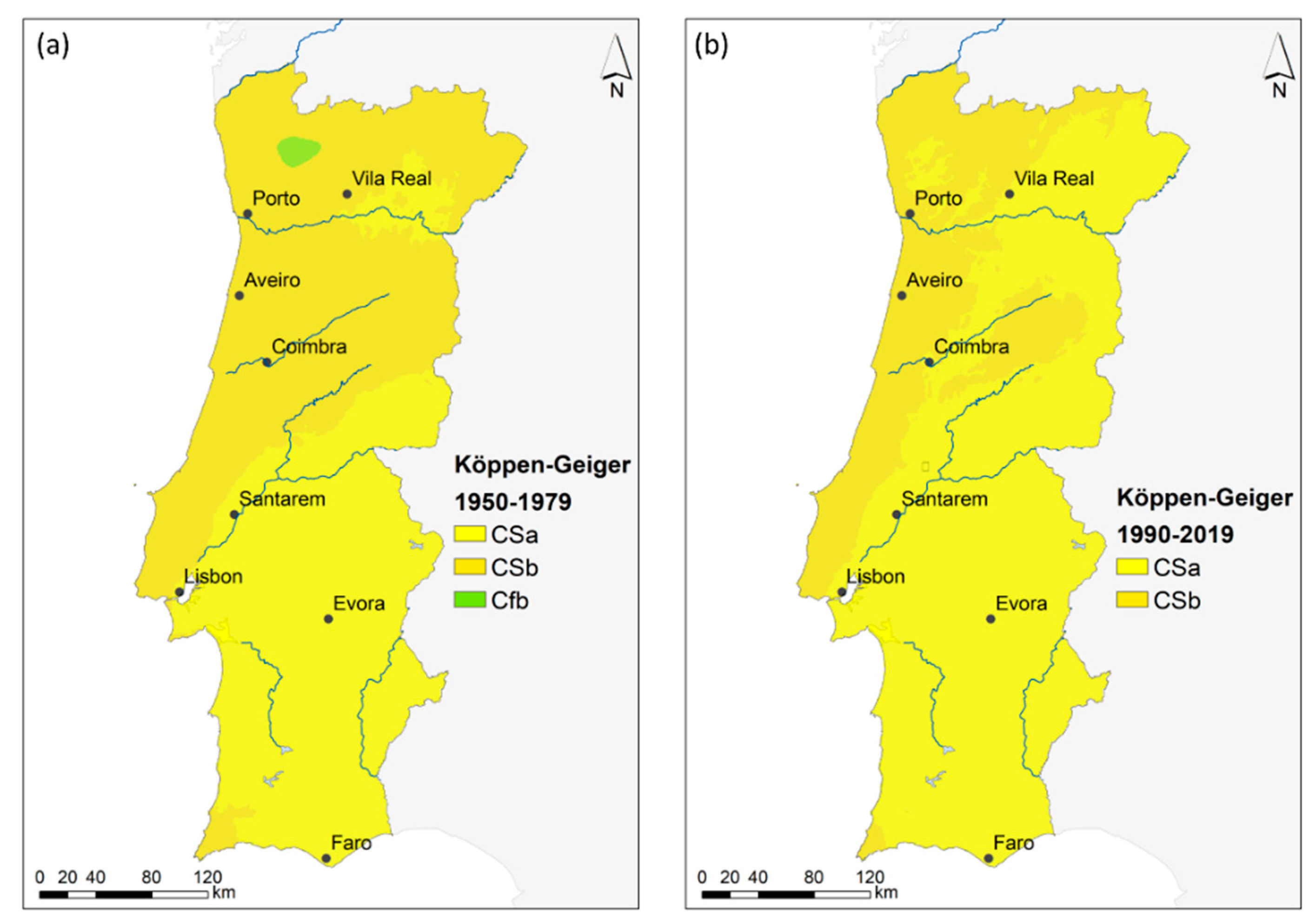
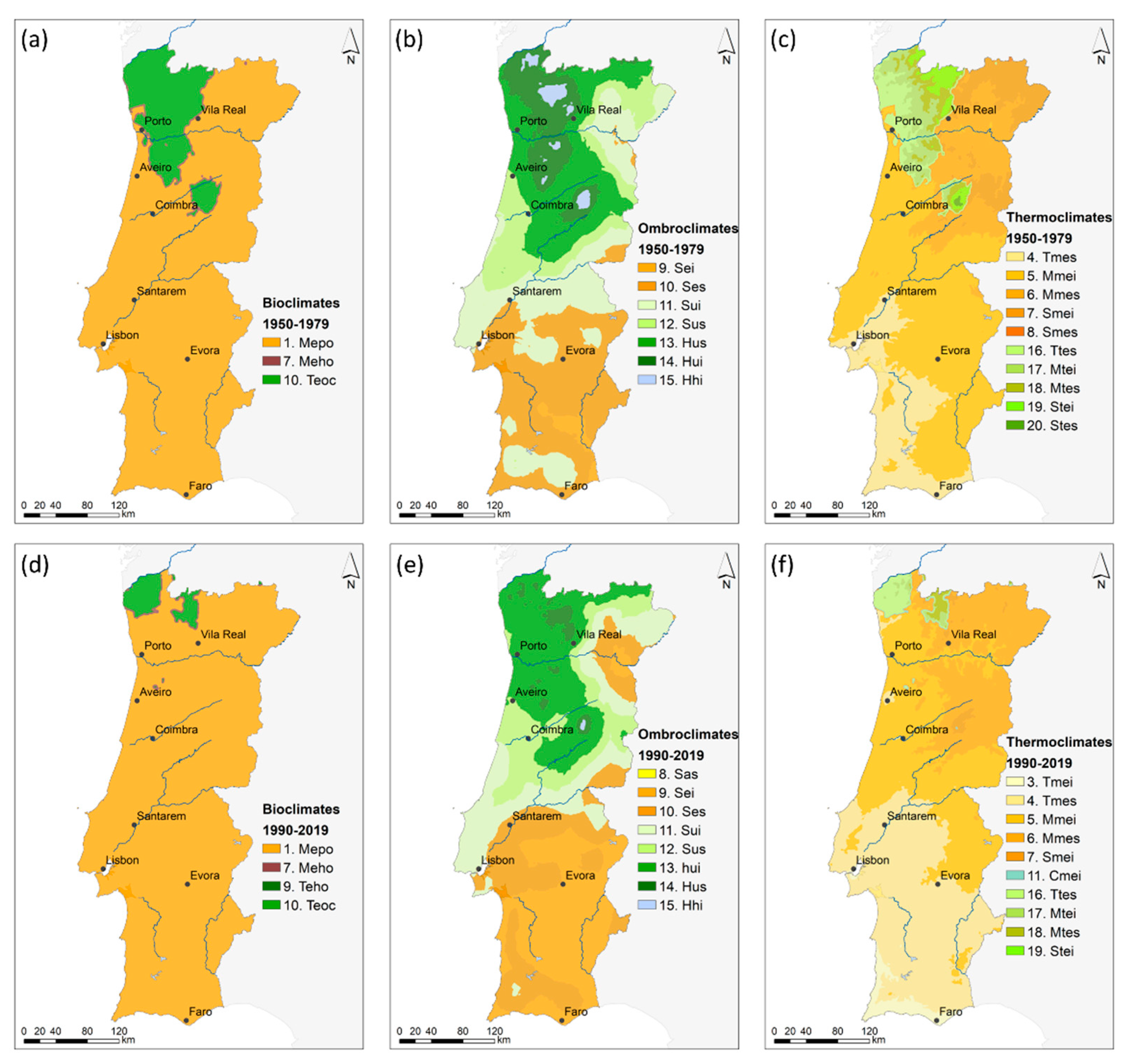
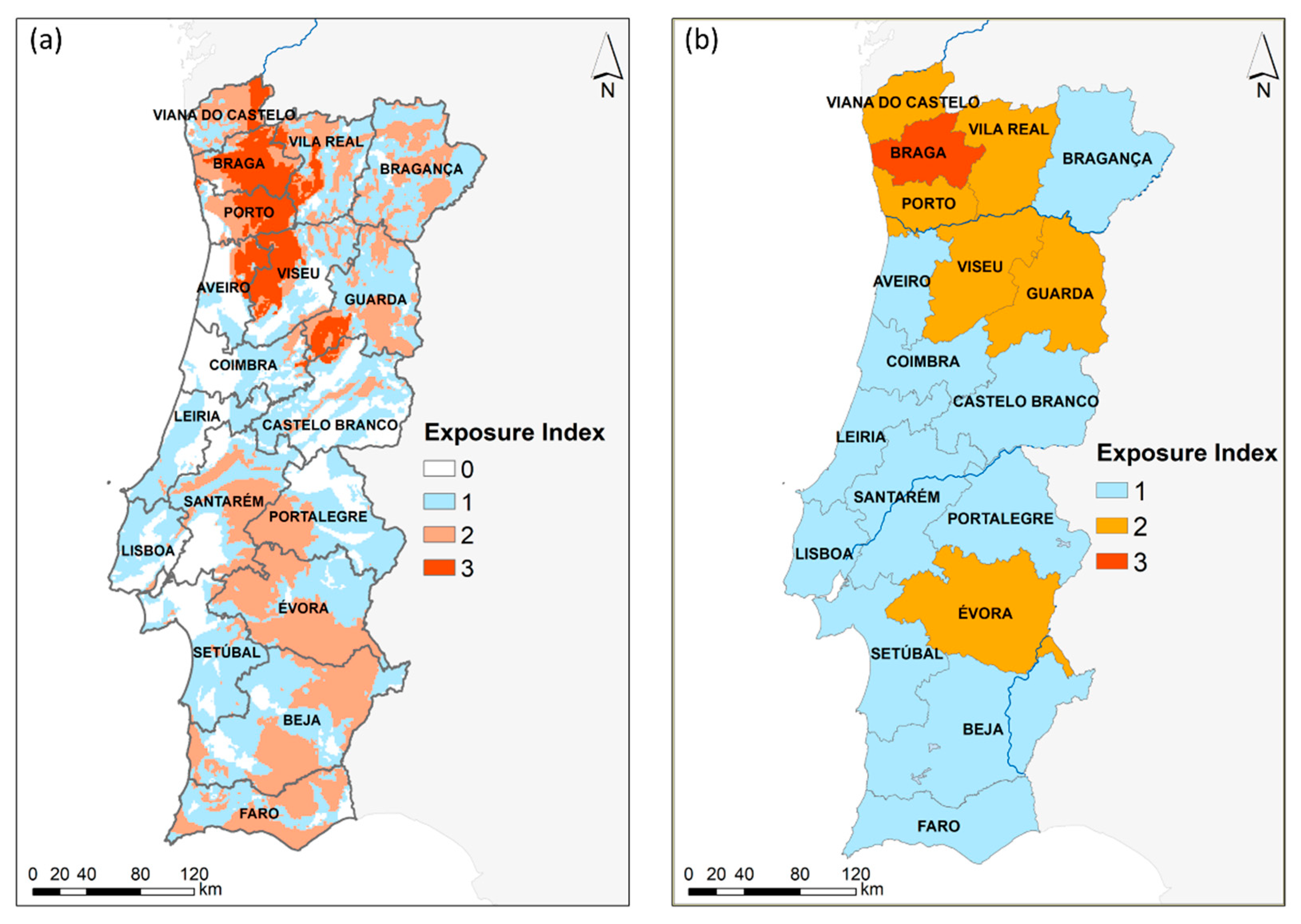
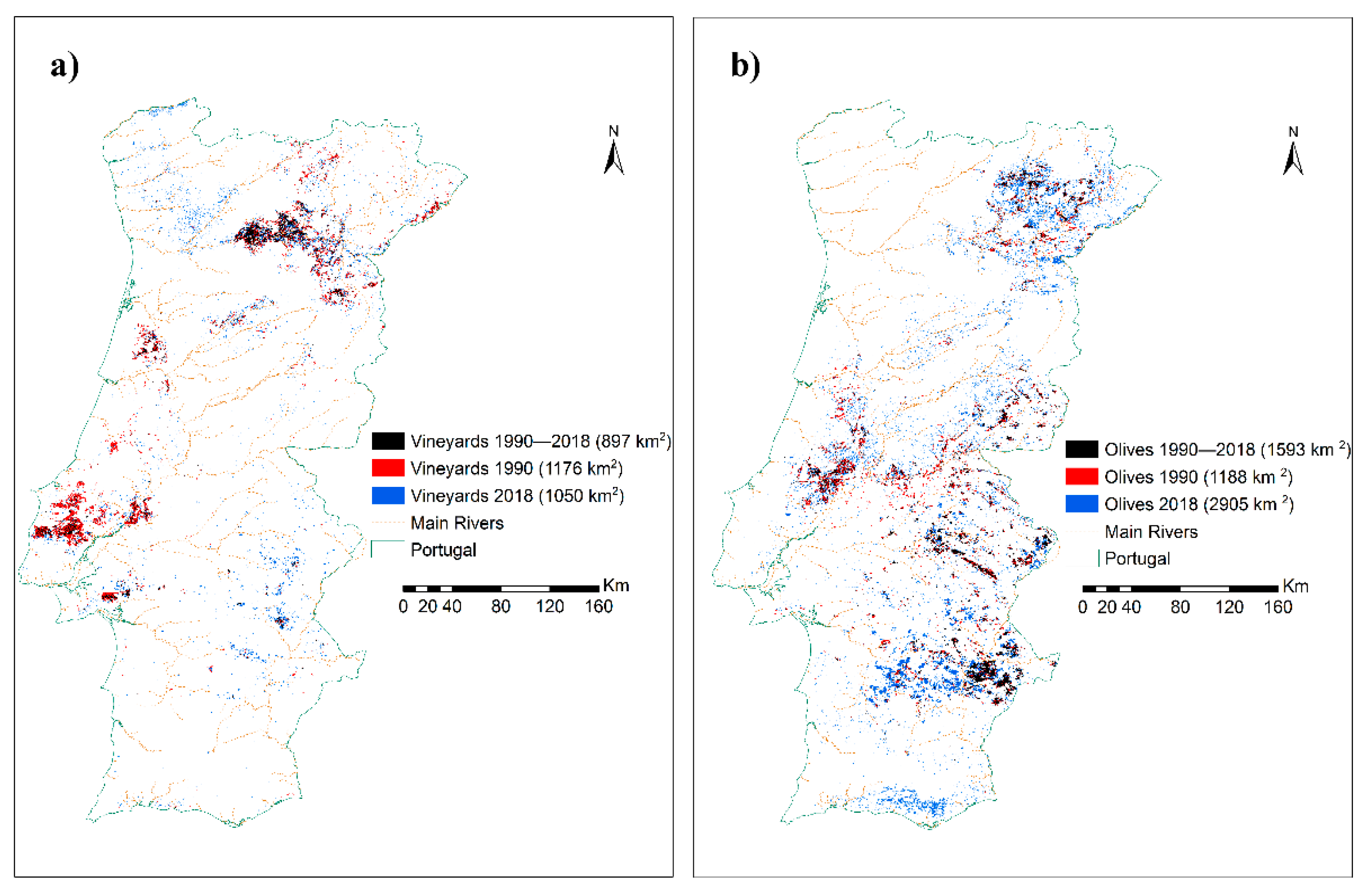
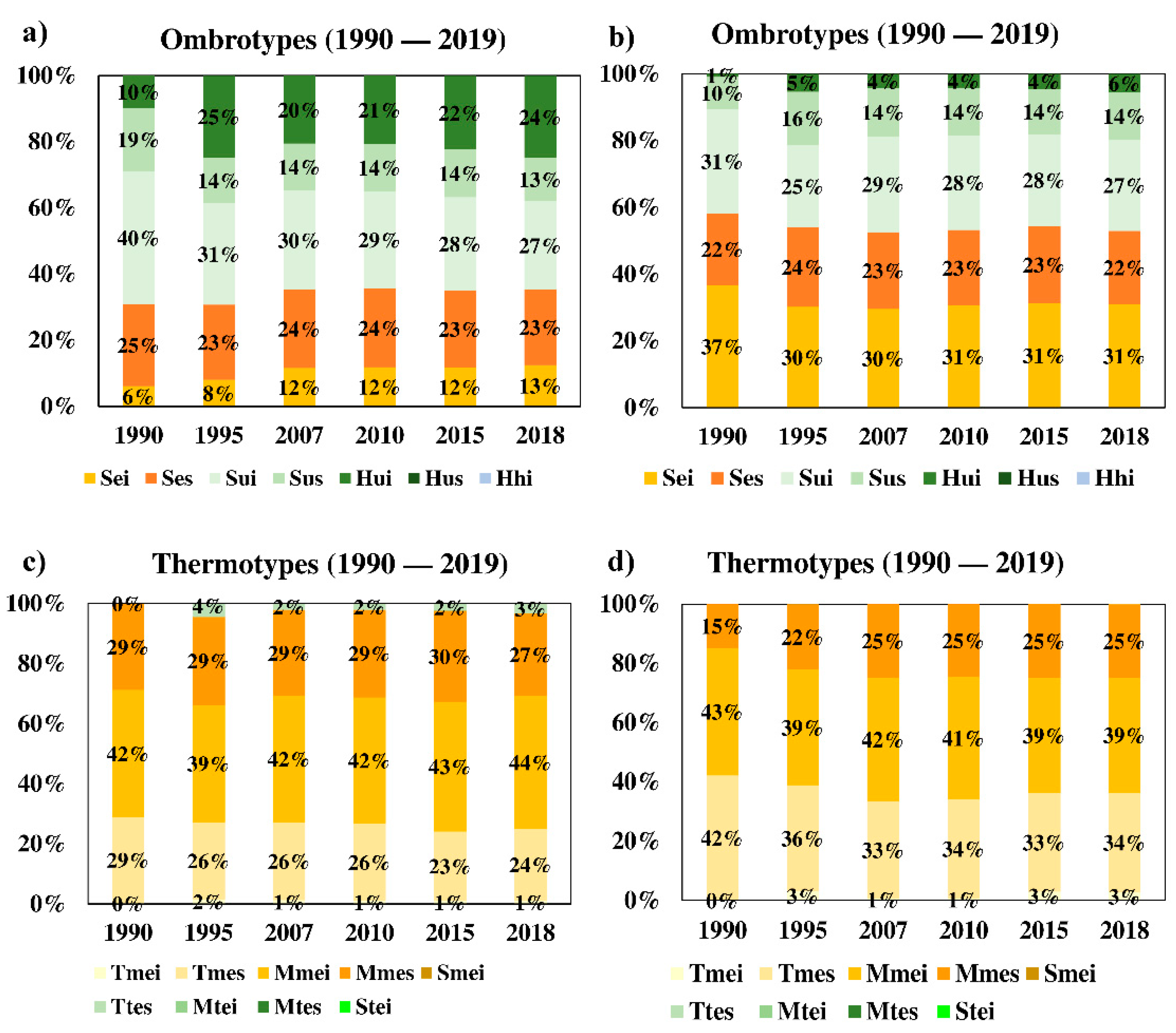
| Bioclimates | Abbr. | CI 1 | OI 1 |
|---|---|---|---|
| 1. Mediterranean pluviseasonal oceanic | Mepo | ≤21 | >2.0 |
| 2. Mediterranean pluviseasonal continental | Mepc | >21 | >2.0 |
| 3. Mediterranean xeric oceanic | Mexo | ≤21 | 1.0–2.0 |
| 4. Mediterranean xeric continental | Mexc | >21 | 1.0–2.0 |
| 5. Mediterranean desertic oceanic | Medo | ≤21 | 0.2–1.0 |
| 6. Mediterranean desertic continental | Medc | >21 | 0.2–1.0 |
| 7. Mediterranean hyperdesertic oceanic | Meho | ≤21 | <0.2 |
| 8. Mediterranean hyperdesertic continental | Mehc | >21 | <0.2 |
| 9. Temperate hyperoceanic | Teho | ≤11 | >3.6 |
| 10. Temperate oceanic | Teoc | 11–21 | >3.6 |
| 11. Temperate continental | Teco | >21 | >3.6 |
| 12. Temperate xeric | Texe | ≥4 | ≤3.6 |
| Ombrothermic Horizons | Abbr. | OI 1 |
|---|---|---|
| 1. Lower ultrahyperarid | Uhai | 0.0–0.1 |
| 2. Upper ultrahyperarid | Uhas | 0.1–0.2 |
| 3. Lower hyperarid | Hai | 0.2–0.3 |
| 4. Upper hyperarid | Has | 0.3–0.4 |
| 5. Lower arid | Ari | 0.4–0.7 |
| 6. Upper arid | Ars | 0.7–1.0 |
| 7. Lower semiarid | Sai | 1.0–1.5 |
| 8. Upper semiarid | Sas | 1.5–2.0 |
| 9. Lower dry | Sei | 2.0–2.8 |
| 10. Upper dry | Ses | 2.8–3.6 |
| 11. Lower subhumid | Sui | 3.6–4.8 |
| 12. Upper subhumid | Sus | 4.8–6.0 |
| 13. Lower humid | Hui | 6.0–9.0 |
| 14. Upper humid | Hus | 9.0–12.0 |
| 15. Lower hyperhumid | Hhi | 12.0–18.0 |
| 16. Upper hyperhumid | Hhs | 18.0–24.0 |
| 17. Ultrahyperhumid | Uhu | >24.0 |
| Thermotypic Horizons | Abbr. | TI 1, Tic 1 | Tp 1 |
|---|---|---|---|
| 1. Lower inframediterranean | Imei | 515–580 | >2600 |
| 2. Upper inframediterranean | Imes | 450–515 | 2400–2600 |
| 3. Lower thermomediterranean | Tmei | 400–450 | 2250–2400 |
| 4. Upper thermomediterranean | Tmes | 350–400 | 2100–2250 |
| 5. Lower mesomediterranean | Mmei | 285–350 | 1800–2100 |
| 6. Upper mesomediterranean | Mmes | 220–285 | 1500–1800 |
| 7. Lower supramediterranean | Smei | 150–220 | 1200–1500 |
| 8. Upper supramediterranean | Smes | 120–150 | 900–1200 |
| 9. Lower oromediterranean | Omei | – | 675–900 |
| 10. Upper oromediterranean | Omes | – | 450–675 |
| 11. Lower crioromediterranean | Cmei | – | 100–450 |
| 12. Upper crioromediterranean | Cmes | – | 1–100 |
| 13. Pergelid | Gme | – | 0 |
| 14. Infratemperate | Ite | >410 | >2351 |
| 15. Lower thermotemperate | Ttei | 350–410 | 2176–2350 |
| 16. Upper thermotemperate | Ttes | 290–350 | 2000–2175 |
| 17. Lower mesotemperate | Mtei | 240–290 | 1700–2000 |
| 18. Upper mesotemperate | Mtes | 190–240 | 1400–1700 |
| 19. Lower supratemperate | Stei | 120–190 | 1100–1400 |
| 20. Upper supratemperate | Stes | – | 800–1100 |
| 21. Lower orotemperate | Otei | – | 590–800 |
| 22. Upper orotemperate | Otes | – | 380–590 |
| 23. Lower criorotemperate | Ctei | – | 100–380 |
| 24. Upper criorotemperate | Ctes | – | 1–100 |
| 25. Pergelid | Gme | – | 0 |
| BSEI | Degree of Exposure |
|---|---|
| 0 | Not exposed |
| 1 | Weakly exposed |
| 2 | Moderately exposed |
| 3 | Highly exposed |
| Köppen–Geiger Climate Classification | 1950–1979 | 1990–2019 | % Change |
|---|---|---|---|
| CSa | 53.90 | 72.00 | ↑ 18.10 |
| CSb | 45.80 | 28.00 | ↓ 17.80 |
| Cfb | 0.03 | 0.00 | ↓ 0.03 |
| Classification | 1950–1979 | 1990–2019 | % Change | |
|---|---|---|---|---|
| Bioclimates | 1. Mepo | 91.40 | 96.18 | ↑ 4.78 |
| 7. Meho | 0.80 | 1.13 | ↑ 0.33 | |
| 9. Teho | 0.00 | 0.03 | ↑ 0.03 | |
| 10. Teoc | 7.80 | 2.66 | ↓ 5.14 | |
| Ombrotypes | 8. Sas | 0.00 | 0.74 | ↑ 0.74 |
| 9. Sei | 3.63 | 27.70 | ↑ 24.07 | |
| 10. Ses | 38.13 | 24.47 | ↓ 13.66 | |
| 11. Sui | 23.98 | 18.54 | ↓ 5.44 | |
| 12. Sus | 10.96 | 11.98 | ↑ 1.02 | |
| 13. Hui | 15.23 | 15.16 | ↓ 0.07 | |
| 14. Hus | 7.07 | 1.37 | ↓ 5.70 | |
| 15. Hhi | 1.00 | 0.04 | ↓ 0.96 | |
| Thermotypes | 3. Tmei | 0.00 | 10.74 | ↑ 10.74 |
| 4. Tmes | 20.73 | 28.89 | ↑ 8.16 | |
| 5. Mmei | 45.35 | 37.25 | ↓ 8.10 | |
| 6. Mmes | 14.32 | 19.06 | ↑ 4.74 | |
| 7. Smei | 9.53 | 0.91 | ↓ 8.62 | |
| 8. Smes | 0.28 | 0.00 | ↓ 0.28 | |
| 11. Cmei | 0.00 | 0.48 | ↑ 0.48 | |
| 16. Ttes | 2.21 | 1.30 | ↓ 0.91 | |
| 17. Mtei | 3.17 | 0.40 | ↓ 2.77 | |
| 18. Mtes | 1.95 | 0.80 | ↓ 1.15 | |
| 19. Stei | 2.31 | 0.17 | ↓ 2.14 | |
| 20. Stes | 0.15 | 0.00 | ↓ 0.15 |
Publisher’s Note: MDPI stays neutral with regard to jurisdictional claims in published maps and institutional affiliations. |
© 2021 by the authors. Licensee MDPI, Basel, Switzerland. This article is an open access article distributed under the terms and conditions of the Creative Commons Attribution (CC BY) license (https://creativecommons.org/licenses/by/4.0/).
Share and Cite
Andrade, C.; Fonseca, A.; Santos, J.A. Are Land Use Options in Viticulture and Oliviculture in Agreement with Bioclimatic Shifts in Portugal? Land 2021, 10, 869. https://doi.org/10.3390/land10080869
Andrade C, Fonseca A, Santos JA. Are Land Use Options in Viticulture and Oliviculture in Agreement with Bioclimatic Shifts in Portugal? Land. 2021; 10(8):869. https://doi.org/10.3390/land10080869
Chicago/Turabian StyleAndrade, Cristina, André Fonseca, and João Andrade Santos. 2021. "Are Land Use Options in Viticulture and Oliviculture in Agreement with Bioclimatic Shifts in Portugal?" Land 10, no. 8: 869. https://doi.org/10.3390/land10080869
APA StyleAndrade, C., Fonseca, A., & Santos, J. A. (2021). Are Land Use Options in Viticulture and Oliviculture in Agreement with Bioclimatic Shifts in Portugal? Land, 10(8), 869. https://doi.org/10.3390/land10080869








